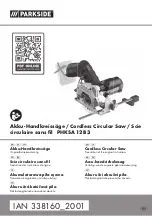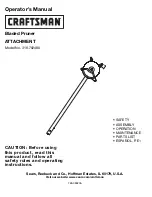
45
45
XVI
d)
Align the fence to be parallel with the saw blade.
A
misaligned fence will pinch the workpiece against the saw blade
and create kickback.
e)
Use a featherboard to guide the workpiece against the
table and fence when making non-through cuts such as
rabbeting.
A featherboard helps to control the workpiece in the event of a
kickback.
f)
Use extra caution when making a cut into blind areas
of assembled workpieces.
The protruding saw blade may cut
objects that can cause kickback.
g)
Support large panels to minimise the risk of saw blade
pinching and kickback.
Large panels tend to sag under their own
weight. Support(s) must be placed under all portions of the panel
overhanging the table top.
h)
Use extra caution when cutting a workpiece that is
twisted, knotted, warped or does not have a straight edge
to guide it with a mitre gauge or along the fence.
A warped,
knotted, or twisted workpiece is unstable and causes misalignment
of the kerf with the saw blade, binding and kickback.
i)
Never cut more than one workpiece, stacked vertically or
horizontally.
The saw blade could pick up one or more pieces and
cause kickback.
j)
When restarting the saw with the saw blade in the work-
piece, centre the saw blade in the kerf so that the saw teeth
are not engaged in the material.
If the saw blade binds, it may
lift up the workpiece and cause kickback when the saw is restarted.
k)
Keep saw blades clean, sharp, and with sufficient set.
Never use warped saw blades or saw blades with cracked
or broken teeth.
Sharp and properly set saw blades minimise
binding, stalling and kickback.
4) Table saw operating procedure warnings
a)
Turn off the table saw and disconnect the battery pack
when removing the table insert, changing the saw blade
or making adjustments to the riving knife, antikickback
device or blade guard, and when the machine is left unat-
tended.
Precautionary measures will avoid accidents.
b)
Never leave the table saw running unattended. Turn
it off and don’t leave the tool until it comes to a complete
stop.
An unattended running saw is an uncontrolled hazard.
c)
Locate the table saw in a well-lit and level area where
you can maintain good footing and balance. It should be
installed in an area that provides enough room to easily
handle the size of your workpiece.
Cramped, dark areas, and
uneven slippery floors invite accidents.
d)
Frequently clean and remove sawdust from under the
saw table and/or the dust collection device.
Accumulated
sawdust is combustible and may self-ignite.
e)
The table saw must be secured.
A table saw that is not
properly secured may move or tip over.
f)
Remove tools, wood scraps, etc. from the table before
the table saw is turned on.
Distraction or a potential jam can
be dangerous.
g)
Always use saw blades with correct size and shape
(diamond versus round) of arbour holes.
Saw blades that do
not match the mounting hardware of the saw will run off-centre,
causing loss of control.
h)
Never use damaged or incorrect saw blade mounting
means such as flanges, saw blade washers, bolts or nuts.
These mounting means were specially designed for your saw, for
safe operation and optimum performance.
i)
Never stand on the table saw, do not use it as a stepping
stool.
Serious injury could occur if the tool is tipped or if the
cutting tool is accidentally contacted.
j)
Make sure that the saw blade is installed to rotate in
the proper direction. Do not use grinding wheels, wire
brushes, or abrasive wheels on a table saw.
Improper saw
blade installation or use of accessories not recommended may
cause serious injury.
Additional Safety and Working Instructions
Dadoing, plowing, resawing and moulding head cutting is prohibited.
Wear ear protectors. Exposure to noise can cause hearing loss.
Use protective equipment. Always wear safety glasses when working
with the machine. The use of protective clothing is recommended,
such as dust mask, protective gloves, sturdy non-slip footwear,
helmet and ear defenders.
The dust produced when using this tool may be harmful to health. Do
not inhale the dust. Use a dust absorption system and wear a suitable
dust protection mask. Remove deposited dust thoroughly, e.g. with
a vacuum cleaner.
Ensure that the machine is always stable and secure.
Before using the tool please read the instructions. If possible have the
tool demonstrated.
Do not use saw blades which are damaged or deformed
Only use saw blades which have been properly sharpened.
Use only woodworking blades specified in this manual, which
comply with EN 847-1.
To minimise noise, the tool must be sharpened and all noise reducing
elements (covers etc.) must be properly adjusted.
Only use tools that meet standard EN 847-1.
Transport and store the tools in a suitable receptacle;
It is necessary to select a saw blade which is suitable for the material
being cut.
It is essential to adhere to the maximum speed specified on the saw
blade.
Do not use saw blades made of high-speed steel.
Do not use abrasion disks in this machine!
REMOVE ADJUSTING KEYS AND WRENCHES. From habit of checking to
see that keys and adjusting wrenches are removed from tool before
turning it “ON”.
Any faults with the machine, including any related to the safeguard
or the saw blades, must be reported to the persons in charge of safety
as soon as the faults are discovered.
Never reach into the danger area of the machine when it is running.
Chips and splinters must not be removed while the machine is
running.
Do not use the top protective cover as a handle for transportation!
Before transporting the machine, make sure that the top protective
guard covers the top section of the saw blade.
Keeping rip fence parallel to the saw blade.
Keep the floor area free of loose material e.g. chips and cut-offs.
In spite of compliance with all relevant design regulations, dangers
may still present themselves when the machine is operated, e.g.:
workpiece parts being thrown off,
parts of damaged tools being thrown off, noise emissions, wood dust
emissions.
Remove the battery pack before starting any work on the
appliance.
WARNING! To reduce the risk of fire, personal injury, and product
damage due to a short circuit, never immerse your tool, battery
pack or charger in fluid or allow a fluid to flow inside them.
Corrosive or conductive fluids, such as seawater, certain industrial
English
Summary of Contents for 4933464225
Page 1: ...Original instructions M18 FTS210 ...
Page 4: ...2 2 I 20 kg 44 lbs Not included in standard equipment 28 mm 4x ...
Page 5: ...3 3 I ...
Page 6: ...4 4 II 2 1 3 ...
Page 7: ...5 5 II 4 5 7 8 6 2 EN 847 1 2 1 1 ...
Page 8: ...6 6 8 9 10 11 1 2 3 8 mm II ...
Page 9: ...7 7 III 0 45 max 63 5 mm max 44 mm ...
Page 11: ...9 9 1 IV 5 25 15 35 45 10 30 40 20 0 2 1 3 ...
Page 12: ...10 10 IV 4 mm 0 3 47 45 4 mm 3 0 45 47 ...
Page 13: ...11 11 V 2 1 3 ...
Page 16: ...14 14 V 1 2 3 ...
Page 17: ...15 15 V 4 A 4 B 6 19 mm ...
Page 18: ...16 16 V 4 C 6 mm ...
Page 19: ...17 17 VI 30 90 45 75 60 60 75 45 30 1 2 3 4 ...
Page 20: ...18 18 A AS 2 250 4931 4472 95 B AS300 AS 30 AS 42 4931 4472 94 VII 1 2 ...
Page 21: ...19 19 VIII Carry out a test cut ...
Page 22: ...20 20 VIII 305 mm 31 5 mm 6 mm 3 mm 63 mm 19 mm 100 mm 70 ...
Page 23: ...21 21 VIII ...
Page 24: ...22 22 VIII ...
Page 25: ...23 23 VIII ...
Page 26: ...24 24 IX 1 2 3 3 8 mm ...
Page 27: ...25 25 IX 1 2 3 ...
Page 28: ...26 26 X 1 2 1 2 ...
Page 29: ...27 27 X TIP 78 100 33 54 55 77 10 32 10 ...
Page 30: ...28 28 XI Start Stop ...
Page 31: ...29 29 XI 2 1 1 2 ...
Page 32: ...30 30 XI 10min 4 3 ...
Page 33: ...31 31 XI 1 2 3 4 ...
Page 34: ...32 32 XI 1 3 2 4 mm 4 mm ...
Page 35: ...33 33 XII 4 4 2 3 1 1 1 2 2 ...
Page 36: ...34 34 XII 4 6 7 5 1 2 EN 847 1 ...
Page 37: ...35 35 89 30 90 00 0 90 XIII ...
Page 38: ...36 36 89 30 90 00 90 XIII ...
Page 40: ...38 38 XIII 2 5 mm ...
Page 41: ...39 39 XIII 5 mm ...
Page 42: ...40 40 XIII 4 mm 4 mm 2 5 mm 89 30 90 00 ...
Page 43: ...41 41 XIV 1 2 3 3V CR2032 ...
Page 44: ...42 42 XV ...




































